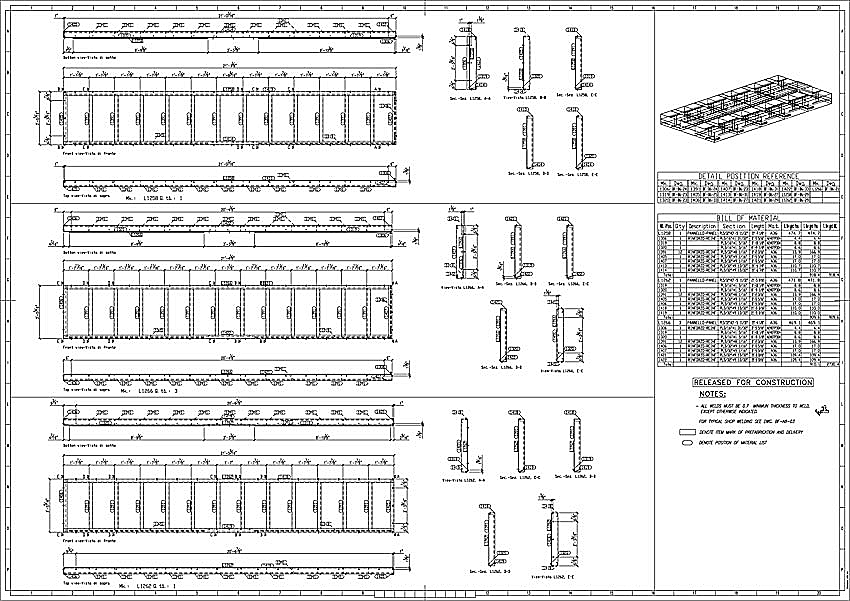Shop drawings
Shop drawings (or workshop drawings) are prepared by contractors, subcontractors, suppliers, manufacturers and fabricators. They generally relate to pre-fabricated components, showing how they should be manufactured or installed. They take design intent drawings and specifications prepared by the project design team and develop them to show in detail how the component will actually be manufactured, fabricated, assembled or installed.
Shop drawings might be prepared for components such as structural steelwork, reinforcement, lifts, building services equipment, appliances, ductwork, piping, plumbing, windows, cabinets, electrical and data layouts, fire protection and so on.
They may be reviewed by the project design team prior to fabrication to verify that they comply with design drawings and specifications and to ensure that different packages of work and components are properly coordinated. This means that they need to contain relevant information to enable this to be done, which might include the provision of samples for approval. However, this does not relieve the originator of the drawings from responsibility for their correct preparation.
Shop drawings may also be used to check installation on site. Suppliers may wish to visit the site before, or during the preparation of shop drawings to verify key dimensions are accurate, particularly on refurbishment or renovation projects.
Where shop drawings vary from design drawings, these variations should be highlighted on the shop drawings and brought to the attention of the design team. This is particularly important to ensure proper co-ordination on site, as fabricators are likely only to refer to the shop drawings, and not the design drawings.
Procedures may be in place for the electronic handling of drawings for comment, review and co-ordination. Where digital drawings are required, file formats, naming and layering conventions may have to be adhered to.
Increasingly, building information modelling is used as a means of managing project information, co-ordinating the design and detecting clashes. This can be useful to suppliers in providing clear information upon which shop drawings can be based, and allowing the shop drawings themselves to be re-incorporated back into the building information model, eliminating time-consuming manual practices and minimising errors.
PAS 1192-2:2013 Specification for information management for the capital/delivery phase of construction projects using building information modelling (now replaced by BS EN ISO 19650) states that, ‘There shall be a 'change of ownership' procedure for the information and objects that specialist sub-contractors introduce to replace the original designers’ intent such that the resulting graphical models can be used for fabrication, manufacture and installation… This change of ownership should be fully understood, specialist teams do not alter the models produced by the professional designers: they build new models defining the virtual construction model (VCM).'
Some suppliers may not yet have the capability of producing BIM information, and this may prove a barrier to winning work.
Increasingly, the preparation of shop drawings is outsourced where the supplier does not have the appropriate skills, software, hardware or resources necessary, or where they may be able to obtain lower rates or faster turnaround. However, this may not properly exploit the expertise of the supplier and places responsibility for preparing important design information with an organisation that is not contractually responsible for it and may not have the detailed knowledge necessary. The supplier should carefully check any shop drawings that are outsourced in this way.
[edit] Related articles on Designing Buildings
- As-built drawings and record drawings.
- Assembly drawing.
- Building information modelling.
- Detail drawing.
- Component drawing.
- Concept drawing.
- Design drawings.
- Drawings.
- General arrangement drawing.
- Installation drawings.
- Notation and units on drawings and documents..
- Production drawing.
- Production information.
- Working drawings.
Featured articles and news
RTPI leader to become new CIOB Chief Executive Officer
Dr Victoria Hills MRTPI, FICE to take over after Caroline Gumble’s departure.
Social and affordable housing, a long term plan for delivery
The “Delivering a Decade of Renewal for Social and Affordable Housing” strategy sets out future path.
A change to adoptive architecture
Effects of global weather warming on architectural detailing, material choice and human interaction.
The proposed publicly owned and backed subsidiary of Homes England, to facilitate new homes.
How big is the problem and what can we do to mitigate the effects?
Overheating guidance and tools for building designers
A number of cool guides to help with the heat.
The UK's Modern Industrial Strategy: A 10 year plan
Previous consultation criticism, current key elements and general support with some persisting reservations.
Building Safety Regulator reforms
New roles, new staff and a new fast track service pave the way for a single construction regulator.
Architectural Technologist CPDs and Communications
CIAT CPD… and how you can do it!
Cooling centres and cool spaces
Managing extreme heat in cities by directing the public to places for heat stress relief and water sources.
Winter gardens: A brief history and warm variations
Extending the season with glass in different forms and terms.
Restoring Great Yarmouth's Winter Gardens
Transforming one of the least sustainable constructions imaginable.
Construction Skills Mission Board launch sector drive
Newly formed government and industry collaboration set strategy for recruiting an additional 100,000 construction workers a year.
New Architects Code comes into effect in September 2025
ARB Architects Code of Conduct and Practice available with ongoing consultation regarding guidance.
Welsh Skills Body (Medr) launches ambitious plan
The new skills body brings together funding and regulation of tertiary education and research for the devolved nation.
Paul Gandy FCIOB announced as next CIOB President
Former Tilbury Douglas CEO takes helm.
UK Infrastructure: A 10 Year Strategy. In brief with reactions
With the National Infrastructure and Service Transformation Authority (NISTA).
























Comments
===Further reading===